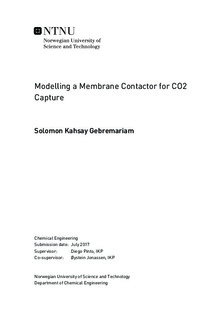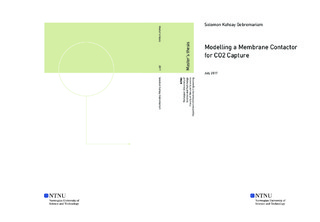| dc.description.abstract | Chemical absorption of CO2 in conventional absorbers is the most mature and preferred
technology today for post-combustion CO2 capture. However, two major bottlenecks of
this technology are the large solvent regeneration energy requirement and the large equipment size. Due to their much higher surface area to volume ratio, membrane contactors
have been suggested as a promising alternative for absorber size reduction. Furthermore,
some novel solvents with low regeneration energy requirement compared to the benchmark solvent (30wt% MEA) have been identified recently. However, at the price of high
volatility, which could lead to solvent losses/emissions when applied in the conventional
absorbers. The use of membrane contactors has also been suggested to overcome this
problem.
Several studies have been performed on CO2 absorption using membrane contactors,
but most of them were conducted at laboratory-scale. Due to the large volume of flue
gases coming from power plants, studies focusing on the modelling and design of large-scale membrane contactors are required. The objective of this thesis has been to develop a
comprehensive two-dimensional mathematical model for CO2 absorption in aqueous MEA
solution in a hollow fiber membrane contactor (HFMC). The developed HFMC model has
been applied for simulation of CO2 absorption from a flue gas of an 800 MWe coal-fired
power plant. This was intended to study the opportunities and challenges of the modelling,
and design of CO2 absorption in large-scale HFMC modules.
The HFMC model is based on mass and heat balance equations for the shell, membrane, and tube sides of the HFMC module. Reversible chemical reactions between CO2
and MEA and the heat of CO2 absorption are considered in the model. The radial variations of the diffusion coefficients of the species in the liquid-phase due to the radial viscosity gradient are also implemented in the model. A rigorous equilibrium model is employed
to estimate the equilibrium partial pressure of CO2 and the initial chemical speciation in
the CO2-MEA-H2O system. The set of partial differential equations in the HFMC model
is developed in the programming language MATLAB and solved using the method of
lines/finite difference method.
The influence of changing the gas-phase velocity, liquid-phase velocity, solvent lean
loading, membrane fiber length, and membrane mass transfer coefficient on the CO2 capture performance of HFMC modules were studied. Results reveal that increasing the gas-phase velocity and membrane mass transfer coefficient, and decreasing the membrane fiber
length enhance CO2 absorption flux. In addition, increasing the membrane fiber length and
membrane mass transfer coefficient, and decreasing the gas-phase velocity enhance CO2
removal efficiency. Solvent lean loading and liquid-phase velocity have a negligible effect
on the performance of the HFMC modules. It was concluded that the main mass transfer
resistance is in the membrane.
Based on the sensitivity analysis, the membrane fiber length was optimized to capture
90% CO2 from the flue gas of the 800 MWe power plant. The volume of the HFMC modules required for 90% CO2 capture was compared with that of a structured packed column
applied for the same case study from the literature. Results show that the HFMC modules
provide a reduced absorber volume (by 86%) and flexibility. However, the study suggested that several challenges, limitations, and factors should be considered in the design
of industrial-scale HFMC modules. These are a precise estimation of the membrane mass
transfer coefficient, gas-phase and liquid-phase pressure drops, limitations in the size of
commercial HFMC modules, lifetime of membranes, and choice of shell-side vs tube-side
liquid-phase flow. The developed HFMC model predicts an axial and radial concentration
and temperature profiles in the liquid-phase. Results show, during 90% CO2 capture, an
excellent radial heat transfer and an axial temperature rise by 20 K in the liquid phase.
The HFMC model results were finally compared with pilot-scale experimental data
from the literature. Based on the comparison, the challenges of predicting the performance
of large-scale HFMC modules are discussed. The limitations of the developed HFMC
model when applied to the simulation of large-scale HFMC modules are also critically
discussed. | |

